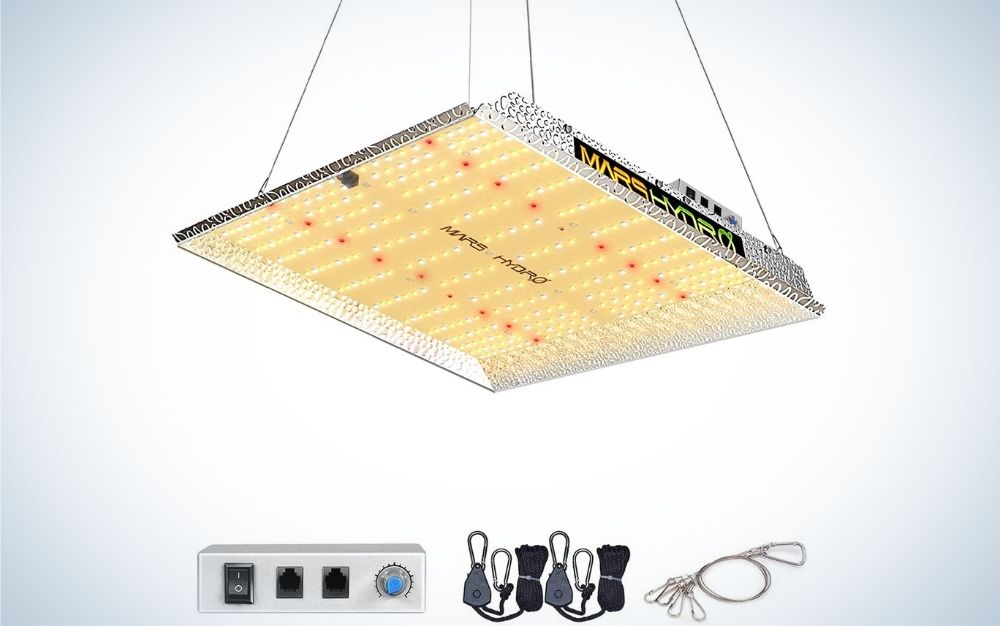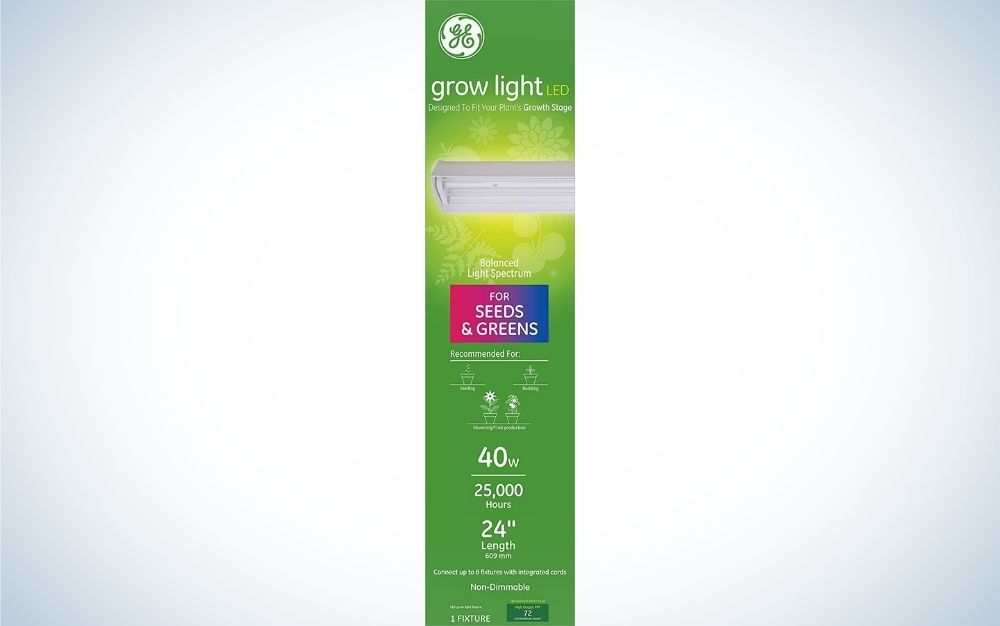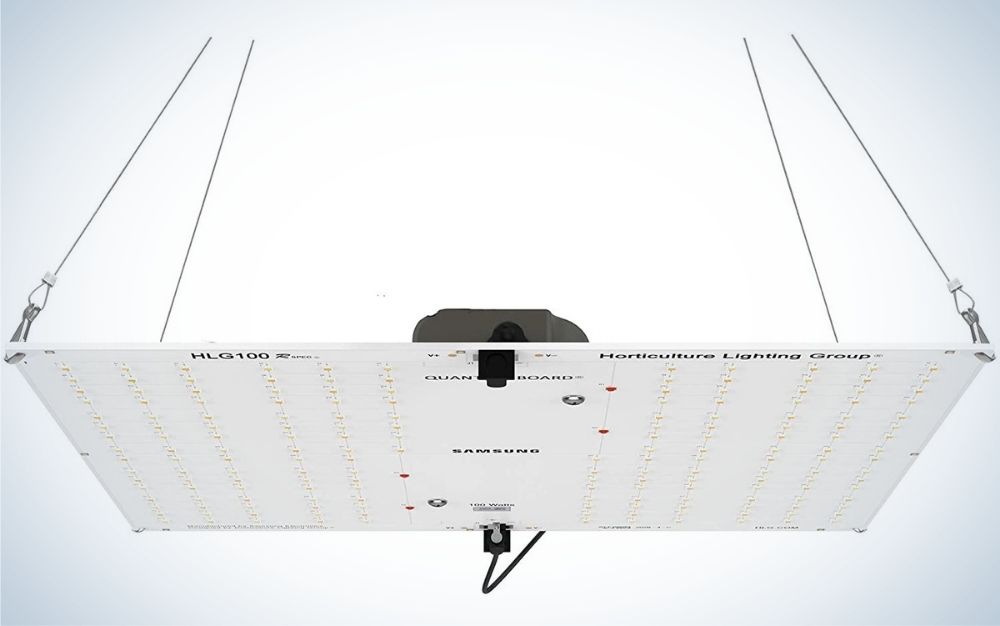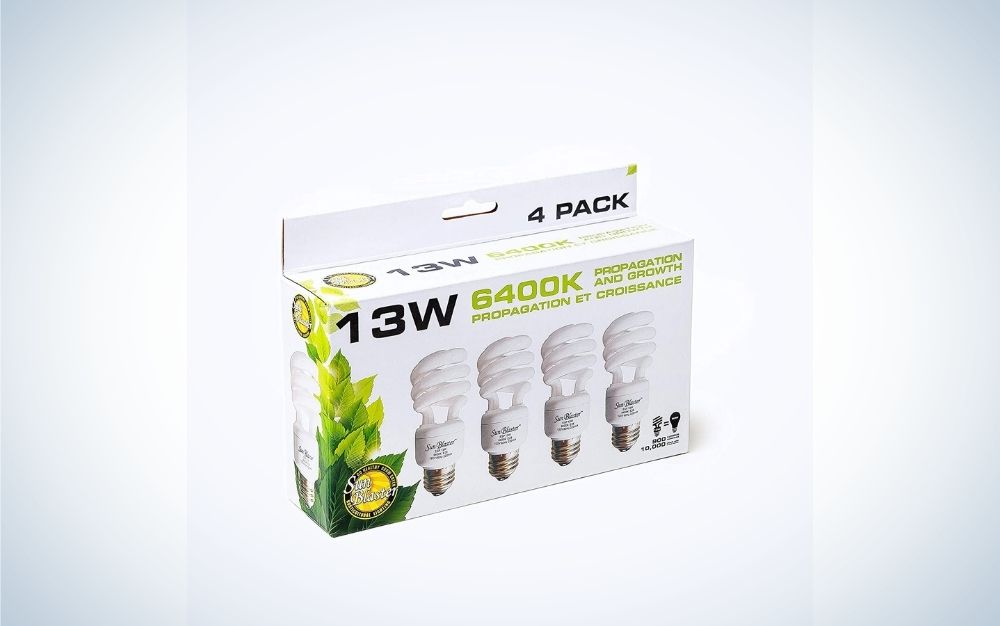
Growing plants indoors can be a great hobby for anyone who doesn’t have a yard or who wants to grow plants all year round. Experienced growers appreciate the amount of control they have over the vitality of the plants simply because an indoor grow setup is isolated from many contaminating factors, like a large number of insect species, uncontrollable temperature changes, and severe storms that could damage the plants.
However, for plants to grow and thrive indoors, they need enough light to carry out the process of photosynthesis. In addition, the amount of natural light that a plant receives throughout the day plays a large part in its life cycle. By increasing or decreasing the amount of light, you can mimic the natural change in seasons and trigger flowering at an increased rate. Or, you can allow the plant to continue to grow, extending the growing season to get a greater yield from a larger plant when it does flower.
The best grow lights offer balanced lighting that is relatively easy to set and control. Many products even have built-in timers that automatically turn the light off after a specified period of time, ensuring the plants don’t get more light than intended. For more information about grow lights, take a look at our tips for picking the best ones for your needs, and check out our picks of the top products.
– Best Overall: MARS HYDRO TS 1000W Led Grow Light
– Best Budget: GE Lighting LED Grow Light
– Best Hanging: HLG 100 Rspec Horticulture Lighting Group Quantum Board
– Best Bulb: SunBlaster 13 Watt CFL Grow Lamp 4 Pack
– Best for Herbs: GrowLED LED Indoor Garden Grow Light
How We Picked The Best Grow Lights
Years of experience in setting up and operating home grows formed the basis for selecting the top grow light products available. However, extensive research into over 30 different products was also necessary to accurately compare the benefits and drawbacks of each option. This included many top-tier products, like Gavita grow lights and Kind LED grow lights, though not every high-quality option was chosen for the list of best grow lights.
Specific attention was given to the brightness of each light, the spectrum of light produced by each product, and the specific type of grow light. Plants typically need access to the entire spectrum of light in order to grow from seedlings to flowering, but the red and blue spectrum of light is the most important for strong, healthy plant development. With this in mind, preference was given to products that were able to produce the full light spectrum at a high enough photosynthetic photon flux density (PPFD) to best facilitate photosynthesis in the plants. In addition, products that boasted any additional features, like a remote control or a built-in timer, were typically preferred over similar grow lights that lacked these features.
The Best Grow Lights: Reviews & Recommendations
Best Overall: MARS HYDRO TS 1000W LED Grow Light

Why It Made the Cut: Compact and efficient, this Mars Hydro grow light is an excellent option that provides up to 343 μmol/s (micromoles per second) of light to help grow strong, healthy plants.
Specs:
– Type: Spread quantum board LED grow lights
– Light Spectrum: White/Full
– Brightness: 343 μmol/s
Pros:
– Great choice for beginners
– Increase or reduce brightness with the included dimmer system
– Works with both 120V and 240V systems
Cons:
– Designed for a small tent
Apartments and condos often only have enough space for a small grow tent, but the MARS HYDRO Grow Light is a compact choice for beginners and experienced growers that lack the space or desire to upgrade to a larger tent. Suitable for grow tents of about 2.5 to 3 square feet, this grow light provides high-efficiency white lighting that is necessary for plants during their entire life cycle. The light is capable of producing up to 343 μmol/s, but it also comes with a dimmer so that the light can be gradually increased or reduced to mimic changing seasons or simply to benefit the growth of the plant.
The MARS HYDRO grow light is a spread style LED light with a square, 3-foot by 3-foot quantum board design. It can be used with both 120V and 240V systems and it comes with the necessary wires to hang the light from a suitable support. Since just one light may not be enough for some larger setups, this grow light is capable of connecting with identical lights to form a dimmer control daisy chain, so users only need to adjust one dial to change the lighting for the entire chain of lights.
Best Budget: GE Lighting LED Grow Tube Light

Why It Made the Cut: Hobby growers can save with this affordable GE grow light that provides full spectrum lighting at 72 μmol/s.
Specs:
– Type: Spread bar LED grow lights
– Light Spectrum: White
– Brightness: 72 μmol/s
Pros:
– Inexpensive investment for a basic setup
– Ideal for lighting shelves
– Daisy chain connection with up to seven additional lights
– Low heat product
Cons:
– Narrow light coverage
Try out a new hobby at an affordable price by investing in this inexpensive GE Lighting LED Grow Light that has a maximum brightness of 72 μmol/s. While the light coverage of this GE grow light is relatively narrow, it is well suited for use on a shelf. Simply place seedlings and smaller plants on a shelf and secure the grow light so that it shines down onto the plants. This method makes good use of the narrow light design and the white spectrum light created by this product is ideal for plants at any stage of life.
Another option is to link up to eight identical GE grow lights in a daisy chain in order to provide light to a much larger area. These spread bar-style LED grow lights have the added advantage of being able to operate without generating excessive heat. This makes them a great choice for smaller tents where the amount of heat produced by larger lights could negatively impact the health of the plants.
Best Hanging: HLG 100 Rspec LED Grow Light

Why It Made the Cut: Connect this hanging HLG grow light to help plants proceed through the full cycle from seedling to flower with full spectrum light production.
Specs:
– Type: Spread quantum board LED grow lights
– Light Spectrum: White
– Brightness: 225 μmol/s
Pros:
– Suitable for soil, hydroponic, aeroponic, and aquaponic systems
– Simple to set up and control
– Passively cooled
– Excellent canopy light penetration
Cons:
– Non-dimmable design
The HLG 100 Rspec Quantum Board Grow Lights are designed for effective lighting without a lot of difficulty during setup. Simply use the included wires and carabiner to hang the light from a central location to provide the best lighting to the target plants. These grow lights can produce up to 225 μmol/s and are best used during plants’ vegetative and blooming stages. However, the white light that these grow lights generate can be used throughout the entirety of the plants’ life cycle, ensuring they receive an adequate amount of light for ongoing photosynthesis.
This HLG grow light has a square spread quantum board design and it is passively cooled so growers won’t need to worry about added noise from a fan. Use this light with just about any type of setup, including soil, hydroponic, aeroponic, and aquaponic systems, but keep in mind that the lights are non-dimmable. This means that the amount of light a plant receives will need to be initially set according to the distance between the plant and the light, and a specific schedule dictating when the light will be on or off.
Best Bulb: SunBlaster 13 Watt CFL Grow Lamp

Why It Made the Cut: High-efficiency fluorescent bulb design can be used in any standard light socket for versatile home grow lighting.
Specs:
– Type: Bulb
– Light Spectrum: White
– Brightness: 16 μmol/s
Pros:
– Versatile use in any standard light socket
– Four-bulb value pack
– Full spectrum lighting
– Up to 10,000-hour lifespan
Cons:
– Low brightness level
Many grow setups take advantage of the efficiency offered by LED lights, but a CFL (compact fluorescent lamp) grow light like the SunBlaster 13 Watt CFL Grow Lamp 4 Pack is still a highly effective method for growing healthy plants. Each bulb in this four-pack produces about 16 μmol/s (which we calculated using the bulbs’ lumen output). It isn’t a lot of light compared to a standard spread quantum board LED grow light, but some houseplants gather natural light through windows and doors, so they only require a small boost in full spectrum lighting to help improve photosynthesis.
Additionally, this pack comes with four bulbs that can each be used in any standard light socket. When used together, the lights can produce 64 μmol/s, and each bulb has an average lifespan of up to 10,000 hours. Tall standing plants can sometimes be difficult to adequately light from above, but these grow light bulbs can be placed in small- or medium-sized lamps to provide full spectrum lighting from an ideal angle.
Best for Herbs: GrowLED LED Indoor Garden Grow Light

Why It Made the Cut: Made for growing herbs indoors, this grow light is an excellent option for a novice grower or a cooking enthusiast.
Specs:
– Type: Spread bar LED grow lights
– Light Spectrum: White
– Brightness: 1153 umol/㎡/s
Pros:
– Designed for growing herbs indoors
– Automatic on/off timer
– Height adjustable
Cons:
– Small coverage area
The GrowLED LED Indoor Garden Grow Light includes a base for seed starters, hydroponic boxes or soil pots, and an extendable arm that holds the light at an ideal height for the current stage of growth. When the plants begin to climb up towards the light, just raise the height of the lights to give the plants room to grow. Due to the grow light’s innovative design, the plants are positioned directly under the light, ensuring that the light isn’t wasted on any of the four sides.
New growers will appreciate this product’s simplicity — it makes it easy to grow herbs right in the kitchen. The grow light also comes with an integrated timer that is automatically set for 16 hours of ongoing operation. The light automatically turns off after this period, replicating an average daylight cycle for the plants. Click and Grow’s Smart Garden 9 is also a great option.
Things to Consider Before Buying The Best Grow Lights
Grow lights are meant to help your plants grow strong and healthy, so it’s important to have a good understanding of what to look for before choosing a product for your setup. Consider the brightness of the light, the light spectrum that each product can produce, and the type of grow light that would be best for the size and configuration of your grow tent.
Brightness
In most circumstances the brightness of a light would be measured in lumens. However, lumens can only be used to measure visible light. Plants are capable of absorbing a wider spectrum of light for photosynthesis, which is known as the photosynthetically active radiation (PAR) zone. So, the PPF and PPFD are required to adequately measure the brightness of a grow light.
– PPF is the standard measurement used for determining the amount of light within the PAR zone created by a single light source per second. Grow light manufacturers measure PPF in micromoles per second (μmol/second). In general, grow lights with a high PPF value are considered more effective, especially if the lights can be dimmed to reduce light when necessary.
– PPFD is the preferred measurement when you know the size of the area where the light will be set up. The PPFD indicates the amount of light within the PAR zone that will actually reach the plants or fall within a given surface area each second. Grow light manufacturers will sometimes provide the PPFD, though it’s important to note the size of the tent or room where the PPFD was set — otherwise, the measurement isn’t as useful for determining the actual output. PPFD is typically measured in micromoles per meter squared per second (μmol/m²/s).
Light Spectrum
Natural light from the sun has a spectrum of waves that includes blue light, purple light, red light, indigo light, infrared light, and more. Plants are exposed to the full spectrum when they grow outdoors, but for indoor setups, you will need to consider light spectrum when choosing the best grow lights. Certain colors are more important for your plants’ growth than others, so it’s common to see grow lights that offer full spectrum white lights as well as others that feature a series of colored lights to better control the plant’s various growth stages.
– Blue light is essential for plants to grow from seedlings because it’s the first color on the light spectrum that can be absorbed by plants when they are still in a vegetative state. It’s also necessary throughout the remainder of the plant’s life to help with photosynthesis, leaf expansion, photoperiodic flowering, and leaf curvature towards light.
– Purple light isn’t as important as blue light, but it can improve photosynthetic processes, especially when the plants are young. Adding purple light at later stages doesn’t harm plants, but the effects of this light decline as most plants mature.
– Red light is another key light on the spectrum for healthy plant growth. It can be used to help seedlings sprout and grow, but the effects of red light aren’t really noticeable until the later stages of growth and budding. Both blue and red light are the most important for growing healthy plants.
– White light is the easiest option to go with, especially for beginner growers, because it contains every color on the spectrum. For this reason, white lights are typically referred to as full spectrum lights by manufacturers. White lights encourage growth throughout the entire plant life cycle, but experienced growers may prefer the precise balance and control over plant development that they can achieve with blue, purple, and red spectrum lights.
Grow Light Types
When it comes to choosing a grow light there are a few different types that can help to customize the setup to your specifications. The appearance, light output, and light spectrum are the main differences between the spread grow lights, chip-on-board (COB) grow lights, and traditional grow lights.
– Spread grow lights typically use a square or rectangular quantum board with a high number of light-emitting diodes. They can also have spider-style arms that each have densely packed LEDs, allowing the grower to maneuver each arm to a suitable position for ideal lighting. Some products consist of a single arm or bar design.
– Bulbs are not commonly used for larger home grows, but if you are providing light for seedling or setting up a standing lamp for a taller plant, grow light bulbs can be an effective way to illuminate your plants.
– Chip-on-Board (COB) grow lights are known to have a higher light density than other LED grow lights. The reason a COB LED grow light can handle more LEDs than a spread or traditional grow light is because of how the LED chips are mounted. By mounting bare LED chips directly to the substrate, multiple LED chips can be used to create a single module in a very tight area.
– Traditional grow lights have a more compact design than spread grow lights, and they typically have a balanced assortment of multicolored LEDs that operate in unison to provide the light that the plant needs instead of relying on white light.
FAQs
Grow lights provide the light necessary to encourage healthy plant growth. This means that the grow lights typically need to be on for 12 to 16 hours, depending on the current stage of growth. For instance, seedlings should typically receive about 14 to 16 hours of natural light per day.
Depending on the size of the setup, grow lights can use a significant amount of energy. However, most home grows are relatively small, so you can expect to pay about $15 to $50 per month in order to operate a grow light for 12 to 16 hours a day.
A home grow doesn’t need to have LED lights for the plants to flourish. LEDs are a popular option because they don’t use a lot of electricity, don’t generate a high level of heat, and they typically last longer than incandescent or fluorescent lights. In most cases LED grow lights are simply the best option.
The initial price of a grow light can range from just $20 to well over $500 depending on the wattage, size, light spectrum, and the type of grow light. Additionally, you might need to pay a bit more on your electric bills — grow lights have a monthly cost of about $15 to $50 for 12 to 16 hours of daily operation.
Final Thoughts on the Best Grow Lights
Beginners and experts alike approve of the full spectrum MARS HYDRO Led Grow Light because it’s easy to use and helps plants flourish through every stage of growth. However, if you prefer a more affordable solution, then the GE Lighting LED Grow Light is a great choice.
This post was created by a non-news editorial team at Recurrent Media, Futurism’s owner. Futurism may receive a portion of sales on products linked within this post.